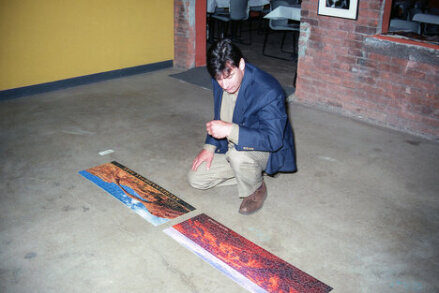Transposed Puzzles
For me, and for many other people I suspect, jigsaw puzzles invoke memories of childhood sick beds; communal family image-making during holiday periods such as Christmas or birthdays, and of course most every bed and breakfast I’ve stayed in has the mandatory unfinished puzzle in the living room . The classic puzzle has cell like units, which differ slightly and only fit into one place. They are mass produced, mechanically cut images of an ideal view or wonderful place. This is their attraction. They are often color enhanced.
Transposing puzzles at Quinebaug College, Connecticut - 2003








The fact that they are mass produced and cut by the same die means that it is possible to transpose pieces from one image to another. This fact has been the essence of my performances using puzzles. Each performance is unique. Transposing the different block arrangements are influenced by either image content or the inherent geometry of the puzzle. Under the guise of being aesthetically and intellectually pleasing, transposing images represents a revolt against the original intent of the puzzle which is to reconstruct the original image back to it’s starting point. Being interchangeable violates the real meaning of why puzzles are made. There is an underlying sense of recalcitrance and sedition. The very interchangeability of the units represents an implicitly subtle and subversive commentary on mass production. The ability to mass die stamp suggests conformity and an acquiescence to the original code, but antithetically having the same structure means this original code of image reconstruction can be broken and transformed. It is a form of poetic rebellion.
Venues for puzzle performances include Stamford Museum, Connecticut; “Qua Qua Qua” Airport Road, Hartford Connecticut, Quinebaug Community College, Danielson, Connecticut, Real Art Ways, Hartford Connecticut and the Jorgenson Art Gallery UCONN, Connecticut.
